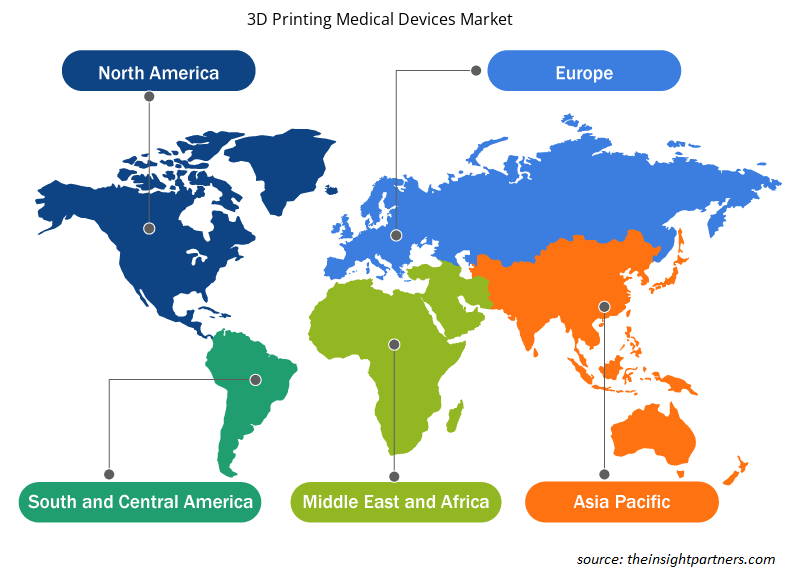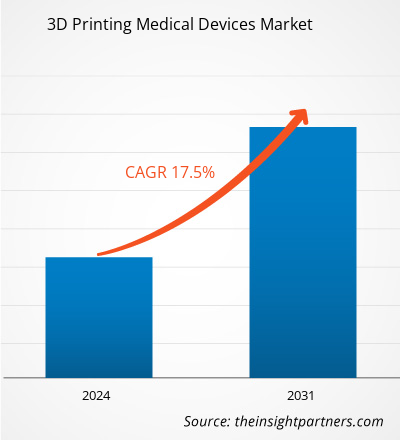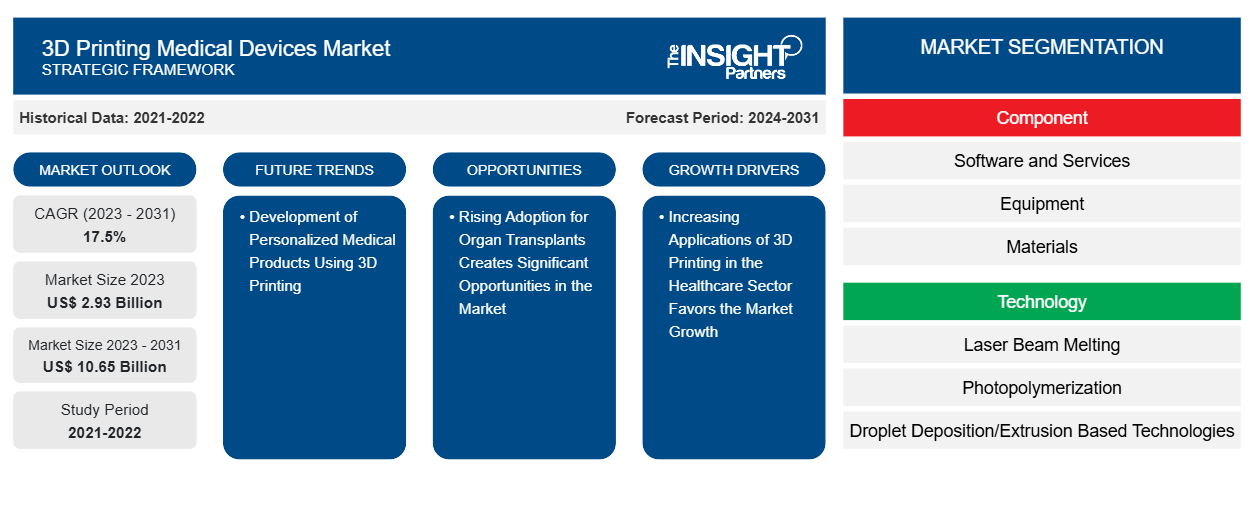3D 打印医疗设备市场规模预计将从 2023 年的 29.3 亿美元增至 2031 年的 106.5 亿美元。预计 2023-2031 年期间市场复合年增长率将达到 17.5%。使用 3D 打印开发个性化医疗产品可能仍将是市场的主要趋势。
3D 打印医疗设备市场分析
3D 打印医疗设备市场已经成熟。3D 打印在医疗保健领域的应用日益广泛,推动了该技术的采用,并促进了市场的整体扩张。器官移植手术数量的增加增加了对 3D 打印医疗设备的需求。这种支持因素影响了整个市场的扩张。不久的将来,通过 3D 打印创建定制医疗产品将为市场扩张带来有利可图的前景。
3D 打印医疗设备市场概况
近几十年来,3D 打印技术在植入式医疗设备中的应用日益广泛,因为它具有精确度高、材料利用率高的特点。创伤学、骨科手术和牙科领域将从这些设备中获益最多。无论多么复杂,任何形状的植入式医疗设备都可以使用 3D 打印技术生产,而不会出现加工问题。它可以解决制造和生产复杂植入式医疗设备的问题。个性化和定制化的植入式医疗设备也可以使用 3D 打印工艺制造。
全球第二大最常见的牙齿疾病是蛀牙。除了性别之间的细微差异外,牙齿矫正问题在男女中都很常见。定制产品的潜力推动了 3D 打印在医疗和牙科应用方面的进步、小规模生产的成本节约、患者图像数据的共享和处理便利以及教育的改善。关于牙周病学和牙髓病学专业应用的出版物有限。3D 打印技术主要侧重于口腔外科和修复学应用,其次是牙齿矫正。由于 3D 打印技术在临床上的应用,外科医生可以使用先进的图像处理技术在逼真的物理解剖模型上进行手术。
定制此报告以满足您的需求
您可以免费定制任何报告,包括本报告的部分内容、国家级分析、Excel 数据包,以及为初创企业和大学提供优惠和折扣
-
获取此报告的关键市场趋势。这个免费样品将包括数据分析,从市场趋势到估计和预测。
3D 打印医疗设备市场驱动因素和机遇
3D打印在医疗保健领域的应用日益增多有利于市场的增长。
使用 3D 打印机可以生产各种具有复杂几何形状或与患者特定解剖结构相对应的特征的医疗设备。标准设计打印一些设备,之后创建相同设备的大量复制品。患者特定的图像数据用于开发其他设备,也称为患者匹配或患者特定设备。打印产品的预期用途和打印机的易用性是选择 3D 打印技术的两个考虑因素。3D 打印医疗设备最流行的技术是粉末床熔合。该方法适用于医疗设备中使用的各种材料,包括尼龙和钛。使用 CT 和 MRI 扫描,3D 打印可以廉价而轻松地创建针对每个患者的触觉参考模型。通过提供不同的视角,这些模型可以帮助医生更好地准备手术,大大减少手术室实际手术所需的时间和金钱。患者可能会从中受益,包括满意度提高、焦虑减少和恢复加快。
此外,在医学领域引入用于 3D 打印的新型生物相容性材料有助于创造新的手术器械和方法,所有这些都旨在增强患者的手术体验。可消毒固定托盘、轮廓模板和植入物尺寸模型是可以通过 3D 打印生产的器械之一。这些可用于在手术室中在初次切割之前确定植入物的尺寸,从而节省外科医生的时间并提高复杂手术的准确性。
器官移植的普及为市场创造了巨大的机遇
3D 打印技术在器官移植中的应用越来越有利。3D 生物打印机经历了多次迭代和改进,以满足质量要求和期望。因此,3D 打印机的创建和开发不断发展,应用范围越来越广。通过加快医疗设备的生产,3D 打印机有助于挽救生命。它们有助于解决器官捐赠者稀缺和接受器官排斥的问题。它还使医疗专业人员能够快速治疗大量患者。如果没有提供血液、氧气和重要营养物质的便捷环境,器官就无法存活。使用 3D 打印技术可以为移植器官创造安全的环境。由于它们是生物打印的而不是阉割的,3D 打印机对医疗领域的器官替换产生了重大影响。这减少了寻找合适捐赠者的时间。因此,预计结果将对社会产生重大积极影响,尤其是在生活质量方面。3D 生物打印的有希望的用途包括制造人造组织和器官,这可能会彻底改变再生医学领域。
3D 打印医疗器械市场报告细分分析
有助于得出 3D 打印医疗设备市场分析的关键部分是组件、技术、应用和最终用户。
- 根据组件,3D 打印医疗设备市场分为软件和服务、设备和材料。设备部分在 2023 年占据了最大的市场份额。
- 根据技术,市场分为激光束熔化、光聚合、基于液滴沉积/挤压的技术和电子束熔化。光聚合领域在 2023 年占据了最大的市场份额。
- 根据应用,市场细分为定制假肢和植入物、组织工程产品、手术导板、手术器械、可穿戴医疗设备、助听器、标准假肢和植入物等。定制假肢和植入物领域在 2023 年占据了最大的市场份额。
- 根据最终用户,市场细分为医院和外科中心、牙科和骨科中心、医疗器械公司、学术和研究机构、制药和生物技术公司等。医院和外科中心在 2023 年占据了最大的市场份额。0
3D 打印医疗设备市场份额(按地区)分析
3D打印医疗设备市场报告的地理范围主要分为五个区域:北美、亚太、欧洲、中东和非洲、南美和中美。
北美由三个国家组成:美国、加拿大和墨西哥。美国是 3D 打印医疗设备的最大市场,其次是加拿大和墨西哥。仅在美国,每年就有近 20 万例截肢手术,假肢更换或改造成本高昂且耗时,价格从 5,000 美元到 50,000 美元不等。由于假肢是个性化设备,因此必须根据佩戴者的规格定制或量身定制。如今,AM 技术经常用于根据每位患者的解剖结构定制假肢组件,以确保完美贴合。AM 可用于假肢与患者接触的地方,因为它能够从各种材料中创建复杂的几何形状。AM 技术已经开发出各种各样的产品,从舒适的假肢腿连接到复杂、高度定制的癌症患者面部假肢。
美国医疗实验室和研究公司 Organovo 已尝试打印肠道和肝脏组织,以帮助进行器官体外研究和开发针对特定疾病的药物。该公司于 2018 年 5 月公布了有关肝脏组织在 1 型酪氨酸血症项目中的功能的临床前数据。酪氨酸是一种氨基酸,由于酶缺乏,人体无法代谢。
3D 打印医疗设备市场区域洞察
Insight Partners 的分析师已详尽解释了预测期内影响 3D 打印医疗设备市场的区域趋势和因素。本节还讨论了北美、欧洲、亚太地区、中东和非洲以及南美和中美洲的 3D 打印医疗设备市场细分和地理位置。

- 获取 3D 打印医疗设备市场的区域特定数据
3D 打印医疗设备市场报告范围
| 报告属性 | 细节 |
|---|---|
| 2023 年的市场规模 | 29.3亿美元 |
| 2031 年市场规模 | 106.5亿美元 |
| 全球复合年增长率(2023 - 2031) | 17.5% |
| 史料 | 2021-2022 |
| 预测期 | 2024-2031 |
| 涵盖的领域 |
按组件
|
| 覆盖地区和国家 |
北美
|
| 市场领导者和主要公司简介 |
|
3D 打印医疗设备市场参与者密度:了解其对业务动态的影响
3D 打印医疗设备市场正在快速增长,这得益于终端用户需求的不断增长,而这些需求又源于消费者偏好的不断变化、技术进步以及对产品优势的认识不断提高等因素。随着需求的增加,企业正在扩大其产品范围,进行创新以满足消费者的需求,并利用新兴趋势,从而进一步推动市场增长。
市场参与者密度是指在特定市场或行业内运营的企业或公司的分布情况。它表明在给定市场空间中,相对于其规模或总市场价值,有多少竞争对手(市场参与者)存在。
3D 打印医疗设备市场的主要公司有:
- EOS GmbH 光电系统
- 雷尼绍 PLC
- Stratasys 有限公司
- 3D 系统公司
- EnvisionTech 公司
- Concept Laser Gmbh(通用电气)
免责声明:上面列出的公司没有按照任何特定顺序排列。

- 获取 3D 打印医疗设备市场主要参与者概览
3D 打印医疗器械市场新闻和最新发展
3D 打印医疗设备市场通过收集一手和二手研究后的定性和定量数据进行评估,其中包括重要的公司出版物、协会数据和数据库。以下列出了 3D 打印医疗设备市场的一些发展情况:
- Align Technology, Inc. 是一家全球领先的医疗器械公司,设计、制造和销售 Invisalign 透明矫正器系统、iTero 口内扫描仪以及用于数字正畸和修复牙科的 exocadCAD/CAM 软件,该公司宣布已完成对私人控股的 Cubicure GmbH 的收购,Cubicure GmbH 是聚合物增材制造直接 3D 打印解决方案的先驱,开发、生产和分销用于新型 3D 打印解决方案的创新材料、设备和工艺。(来源:Align Technology, Inc.,新闻稿,2024 年 1 月)
3D 打印医疗设备市场报告覆盖范围和交付成果
“3D 打印医疗设备市场规模和预测(2021-2031 年)”报告对以下领域进行了详细的市场分析:
- 3D 打印医疗设备市场规模及预测,涵盖全球、地区和国家层面的所有主要细分市场
- 3D 打印医疗设备市场趋势以及市场动态,如驱动因素、限制因素和关键机遇
- 详细的 PEST/波特五力分析和 SWOT 分析
- 3D 打印医疗设备市场分析涵盖主要市场趋势、全球和区域框架、主要参与者、法规和最新的市场发展。
- 行业格局和竞争分析,涵盖市场集中度、热图分析、知名参与者以及 3D 打印医疗设备市场的最新发展
- 详细的公司简介
- 历史分析(2 年)、基准年、预测(7 年)及复合年增长率
- PEST和SWOT分析
- 市场规模、价值/数量 - 全球、区域、国家
- 行业和竞争格局
- Excel 数据集
近期报告
相关报告
客户评价
购买理由
- 明智的决策
- 了解市场动态
- 竞争分析
- 客户洞察
- 市场预测
- 风险规避
- 战略规划
- 投资论证
- 识别新兴市场
- 优化营销策略
- 提升运营效率
- 顺应监管趋势























 获取免费样品 - 3D打印医疗设备市场
获取免费样品 - 3D打印医疗设备市场